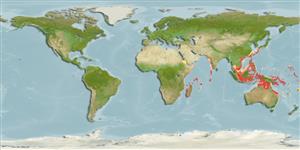>
Gobiiformes (Gobies) >
Gobiidae (Gobies) > Gobiinae
Etymology: Oplopomus: Greek, hoplon = weapon + Greek,poma, -atos = cover, operculum (Ref. 45335).
More on author: Bleeker.
Environment: milieu / climate zone / depth range / distribution range
Ecologia
marinhas associadas(os) a recifes; intervalo de profundidade 1 - 66 m (Ref. 86942). Tropical
Indo-West Pacific: Maldives. Also reported from New Caledonia (Ref. 11889).
Tamanho / Peso / Idade
Maturity: Lm ? range ? - ? cm
Max length : 7.5 cm SL macho/indeterminado; (Ref. 48637)
Descrição suscinta
Chaves de identificação | Morfologia | Morfometria
Espinhos dorsais (total) : 6 - 7; Raios dorsais (total) : 10; Espinhos anais: 1; Raios anais : 10. Characterized by pale grey body color with numerous small white dots and larger brown spots on head and body; row of four large ovate blotches along side at level of pectoral fin base; base of caudal fin with additional spot; united pelvic fins, well developed frenum present; rounded caudal fin, slightly shorter than HL; longitudinal scale series 28-29; ctenoid scales on body and nape; cycloid scales on prepectoral area, breast, cheek and opercle; predorsal scales about 12; 1-2 small spines on preopercular margin just above angle; depth of body 4.2-4.7 in SL (Ref. 90102).
Inhabits coastal sand and mud flats, mainly in deepest parts of estuaries and at moderate depth, about 20 meters, in coastal bays (Ref. 48637).
Ciclo de vida ou comportamento de acasalamento
Maturities | Reprodução | Spawnings | Egg(s) | Fecundities | Larvas
Randall, J.E. and M. Goren, 1993. A review of the gobioid fishes of the Maldives. Ichthyol. Bull. J.L.B. Smith Inst. Ichthyol. (58):1-37, 5 pls. (Ref. 9360)
Status na Lista Vermelha da UICN (Ref. 130435)
Ameaça para os humanos
Harmless
Uso pelos humanos
Ferramentas
Relatórios especiais
Baixar XML
Fontes da internet
Estimates based on models
Preferred temperature (Ref.
123201): 25 - 29, mean 28 °C (based on 866 cells).
Índice de diversidade filogenética (Ref.
82804): PD
50 = 0.7500 [Uniqueness, from 0.5 = low to 2.0 = high].
Bayesian length-weight: a=0.00708 (0.00333 - 0.01504), b=3.09 (2.92 - 3.26), in cm total length, based on LWR estimates for this (Sub)family-body shape (Ref.
93245).
Nível Trófico (Ref.
69278): 3.3 ±0.4 se; based on size and trophs of closest relatives
Resiliência (Ref.
120179): Elevada, tempo mínimo de duplicação da população menor que 15 meses (Preliminary K or Fecundity.).
Fishing Vulnerability (Ref.
59153): Low vulnerability (10 of 100).
Nutrients (Ref.
124155): Calcium = 154 [68, 299] mg/100g; Iron = 0.817 [0.398, 1.595] mg/100g; Protein = 17.8 [15.8, 19.5] %; Omega3 = 0.106 [0.045, 0.206] g/100g; Selenium = 28.3 [12.6, 66.3] μg/100g; VitaminA = 141 [37, 513] μg/100g; Zinc = 2.19 [1.40, 3.30] mg/100g (wet weight);
